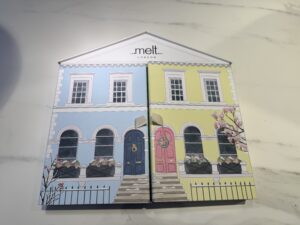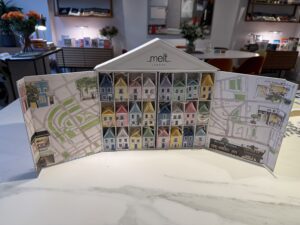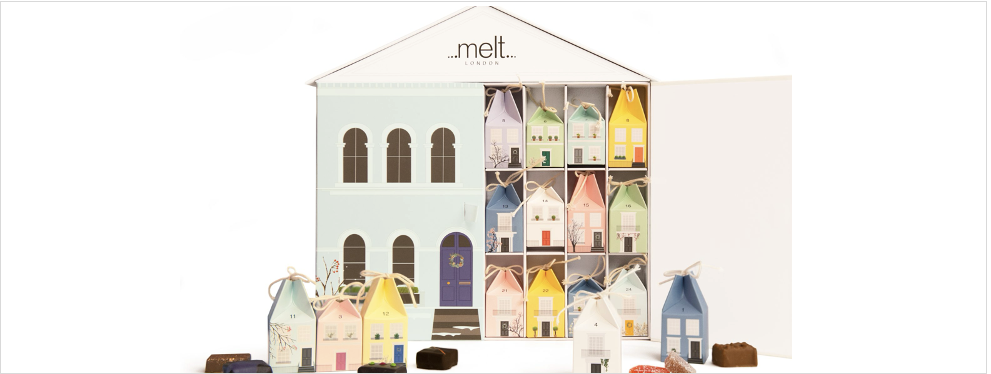Every December, since our three girls were small, a Taylor family tradition is having an advent calendar with chocolate treats for each of the 24 days leading up to Christmas Day. Our girls are grown up now, but still look forward to the moment the advent calendar arrives! And this year, a Facebook ad grabbed my attention, from a brand called Melt: “London’s Most Luxurious Chocolate Company”. The Melt advent calendar was inspired by the beautiful, colourful houses of Notting Hill, featured in the movie of the same name starring Hugh Grant.
The calendar created such an amazing reaction when it arrived this week, I felt I had to do a post on this marvellous bit of Christmas marketing! Below I share some of the inspiration for your marketing, at Christmas or any time of the year.
1. Create a “wow” reaction
“With excellent ingredients, skill, experience and imagination, our chocolatiers are able to create wonderfully innovative chocolates and bars,” as the company says on their website (1). The Melt advent calendar is certainly is an example of this approach in action, creating a sense of wonder in our home. I have never seen such an enthusiastic reaction to any package that arrived our front door (and believe me we get a lot of packages each week)!
You open up the front doors of the adjoining houses on the calendar (below left) to reveal 24 perfectly formed little houses (below left). There is also a map of Notting Hill with other London landmarks.


Each house has a different colour, with “delicious, fresh, organic, bespoke, fresh chocolates behind each of their 24 doors” (1). 

2. Seek inspiration from different sources
Consumer insight is a good source of new ideas, but not the only one. Great brands look beyond the obvious for inspiration. This is especially the case for smaller companies , like Melt, that lack the big budgets to do lots of research. “Melt is the antithesis of corporate, which gives us the opportunity to be truly creative,” the company explains. “Recipes can be inspired by a mood, a person, an encounter, or a chat with a customer”.
3. Build on a brand truth
The calendar builds on a brand truth, as Melt itself is based in the heart of Notting Hill. “As a dedication to a world-renowned location and the many picturesque historic houses, we bring to you our Notting Hill Luxury Advent Calendar House.” The Notting Hill calendar reinforces the sense of provenance and specifically having a home in an aspirational location. In addition, the calendar cleverly name-checks other upscale brands including Daunt Books and Ottolenghi. This approach reinforces the brand’s luxury status.
4. Drive distinctiveness
This advent calendar looks like no other calendar I’ve seen. It really stands out from what is a very crowded Christmas chocolate market, including other luxury chocolate brands like Hotel Chocolat and Rococo. The latter also charge premium prices but look much more standard (see below).
This distinctiveness helps the brand get noticed. It also creates the wow factor mentioned earlier, increasing the chances of generating word of mouth and word of mouse.

5. Execute with excellence
One more thing I love about the Melt advent calendar is the excellence of execution. The card is of high quality, the attention to detail is impressive, with each house having not only a different colour but a different design and garden. You can sense the love put into not just the concept but the production too. “This gourmet chocolate advent calendar is a cocoa creation we hold close to our heart,” the company says on their website.
Clearly this level of perfection doesn’t come cheap. It required heavy investment from Melt. As an independent company they have more freedom to pour money into a passion project they believe in.
6. Re-frame your market
At first sight, the Melt Advent calendar has a hefty price tag of £79.99. This is c. 8-10 times what you would pay for an advent calendar from a “mass premium” chocolate brand like Lindt. However, when I showed a picture of the Melt calendar to Mrs Taylor before hitting “Buy” and asked what she thought the price was, her guess was in the £200 region!
This example shows the importance of framing your market correctly. Defining the market as “chocolate advent calendars” could have led Melt do create something predictable, priced more like the Hotel Chocolate calendar shared earlier (c. £30). However, define the market as “luxury advent calendars” and your view on price and value changes. Advent calendars from brands like Jo Malone and Dior (see below) are priced at £180-£300. This maybe explains why Anne-Marie guessed a price in this sort of range. Suddenly, a £79.99 luxury advent calendar represents great value! After all, you are buying not just chocolate, but “a chance to take a bit of Notting Hill home with you” (1).

7. Pass the taste test
And what about the taste of the chocolates themselves, which include Chestnut Pate de Fruit, Gingerbread Caramel and Orange Praline? Well, we have to wait a while to start eating the chocolates, so I will update you in 2025! Accolades from the Evening Standard (2) and BBC Good Foods (3) do suggest we have a treat in store!
In conclusion, the Melt advent calendar shows how to use a brand truth as inspiration to create a wonderful, highly distinctive product with the potential to drive word of mouth.
SOURCES
1. Melt Advent Calendar
3.’Best Advent Calendars for foodies 2024’ by BBC Good Foods
